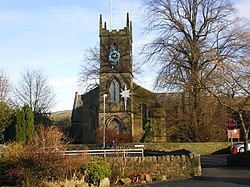Kelbrook
| Kelbrook | |
| Yorkshire West Riding | |
|---|---|
 St Mary's Church, Kelbrook | |
| Location | |
| Grid reference: | SD902447 |
| Location: | 53°53’53"N, 2°8’56"W |
| Data | |
| Post town: | Barnoldswick |
| Postcode: | BB18 |
| Dialling code: | 01282 |
| Local Government | |
| Council: | Pendle |
| Parliamentary constituency: |
Pendle |
Kelbrook is a village in the West Riding of Yorkshire, on the A56 road between Colne and Earby. It forms part of the civil parish of Kelbrook and Sough.
The village originates as a division of the ancient parish of Thornton-in-Craven in the Staincliffe Wapentake.
Kelbrook School is situated in the heart of the village. The highest building in the village is the village church, St Mary's of Kelbrook. Other local towns and villages are: Barnoldswick, two miles west; Earby, a mile north; Salterforth, a mile west; Thornton in Craven, two miles north; Foulridge, two miles south; and Colne, 3½ miles south.
Elisabeth Beresford, the creator of the Wombles, wrote much of the second Wombles book, The Wandering Wombles, whilst staying in a cottage on Dotcliffe Road in 1970. The Kelbrook and Sough Wombles, the local litter-picking group made up of local residents, is named in tribute to this local nexus.[1] Edward Woodward lived in Kelbrook for six weeks in 1973 whilst preparing for his role in the Wicker Man.
The residents of Kelbrook are affectionately called Kelbricks.
This village has many charming customs, for instance during a wedding it is tradition for young residents of the village to lock the church gates and demand money from the bride and groom.[2] A more recent custom is to make scarecrows of literary characters from children's books[3] and to race ducks.[4] on Kelbrook Beck.
Tourism
The main A56 road runs through the village. Kelbrook has one public house named the Craven Heifer,[5] named after a local cow, the eponymous Craven Heifer, which was born in 1807 and achieved nationwide fame due to its size.[6] The public house was previously named the Scotsmans Arms. The public house changed name between 1853 and 1891.
Other attractions include the Kelbrook Pottery factory [7] and the annual art exhibition.[4] The village also has a fish and chip restaurant [8] and a petrol station with a shop.[9]
References
| ("Wikimedia Commons" has material about Kelbrook) |
- ↑ Staff (5 April 2007). "The Kelbrook and Sough Wombles?". Burnley Express. http://www.burnleyexpress.net/barnoldswickearbynews/The-Kelbrook-and-Sough-Wombles.2228365.jp.
- ↑ "Kelbrook". VisitorUK.com. http://www.visitoruk.com/historydetail.php?id=18198&cid=592&f=Skipton.
- ↑ Staff (14 May 2010). "Kelbrook to stage debut scarecrow festival". Craven Herald & Pioneer. http://www.cravenherald.co.uk/news/8161937.Scarecrows_bring_book_characters_to_life/.
- ↑ 4.0 4.1 "Annual Events". Kelbrook Village Hall. http://www.kelbrookvillagehall.org/annual.html.
- ↑ "The Craven Heifer Inn". http://www.thecravenheiferinn.co.uk/.
- ↑ "History". The Craven Heifer. Archived from the original on 2009-07-01. https://web.archive.org/web/20090701065435/http://www.cravenheifer.co.uk/history.cfm.
- ↑ "Kelbrook Pottery". http://www.kelbrookpottery.com/.
- ↑ "Michelles". http://www.tripadvisor.co.uk/Restaurant_Review-g1788381-d3219645-Reviews-Michelle_s_Restaurant_Takeaway-Kelbrook_Lancashire_England.html.
- ↑ "Kelbrook Co-Operative store". http://www.co-operative.coop/store/food/BB18-6TG/colne-road.